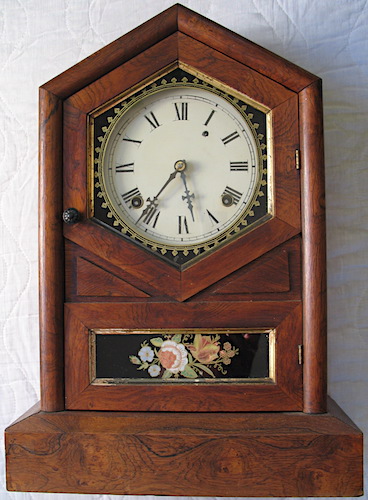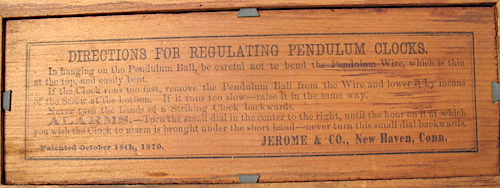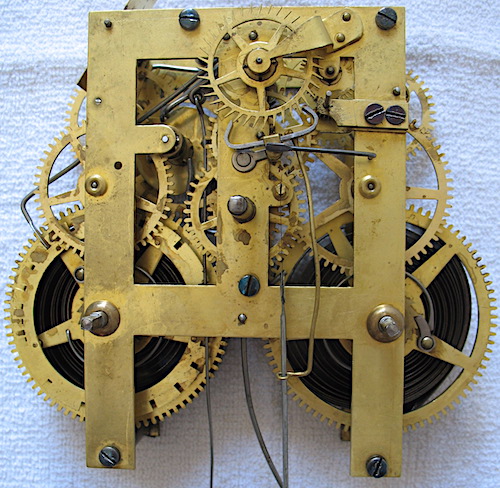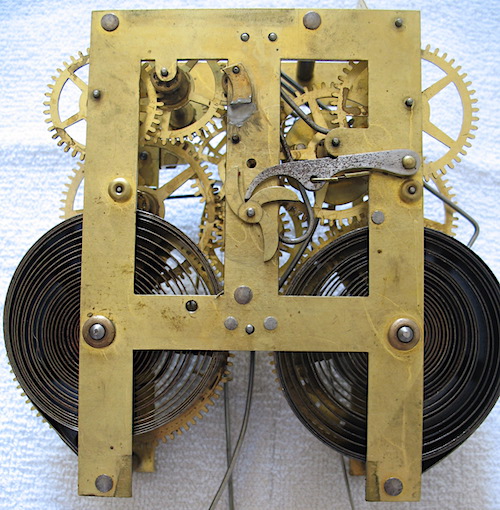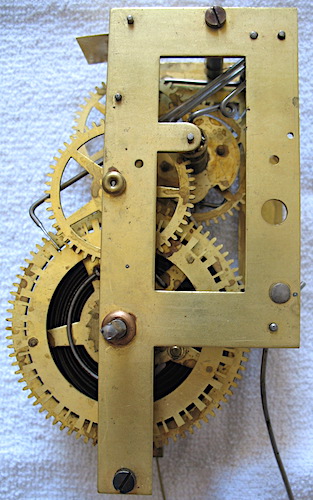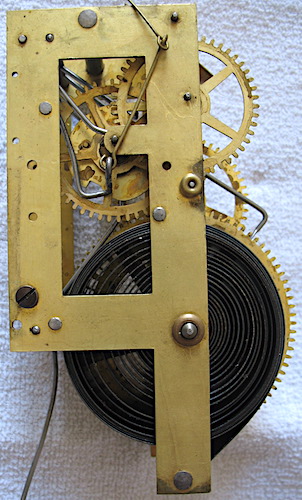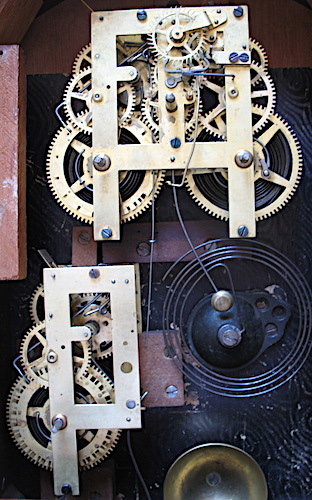This is an unusual clock with perhaps more questions than answers. As far as what it is, it’s a quarter-striking, 8-day clock, apparently by S.B. Jerome and dating to around 1870. It is the only quarter-striking clock I’ve ever seen by S.B. Jerome, which is what leads to the questions, the first of which has to do with the originality of the quarter-striking mechanism. At this point, all I can conclude is that there are no obvious signs that the clock has been altered. Another question is with respect to the originality of the triangular wood elements on the sash below the octagonal-shaped surround for the dial. These spaces were typically occupied by round medallions made of a composite material, sometimes (incorrectly) referred to as gutta percha. There is also a question about the seconds bit (hole visible just below the Roman numeral I on the dial). The position is odd, and there are no markings for the seconds bit. Clearly, markings would not fit well, considering the position of the seconds bit relative to the chapter ring. The tricky thing about the unusual features associated with this clock is that they could easily have been added at a later date.
Typical Jerome & Co. label (this being S.B. Jerome’s company, not the trade name used by the New Haven Clock Co.). The Oct. 18th, 1870 patent referred to in the label is for the design of the sash (door).
Front view of the 8-day, spring-driven Noah Pomeroy movement. Jerome & Co. clocks typically have Pomeroy movements. The movement has a subsidiary gear added to drive a seconds bit (which was not with the clock when purchased). The shaft for the seconds bit can be seen at roughly 4 o’clock relative to the escape wheel. What was not clear to me until I posted this clock to the NAWCC message board was that the movement is not a “standard” Pomeroy movement. Standard movements had a recoil escapement, and this movement has a deadbeat escapement patented by Pomeroy in 1869 (patent shown at the bottom of the page).
Rear view of the Pomeroy movement. Note the three-armed cam that interacts with the lever connecting to the quarter-striking movement.
Front view of the quarter-striking mechanism. In essentially all details, this is simply the strike side of a standard Pomeroy movement. However, the slots on the count wheel have been cut for a simplified quarter-strike, as opposed to slots spaced for counting the hours. Notice that there are unoccupied holes in the front plate that correspond to the motion works in a standard Pomeroy movement.
Rear view of the quarter-striking mechanism. Notice the hinged brass wires that connect to the main movement and that activate the quarter-strike.
View from the rear showing how the movement and quarter-striking mechanism are positioned relative to one another, with the hinged brass wires connecting the two.
Front view with the movements mounted in the case. The gong is not original; the bell may or may not be.
S.B. Jerome shelf clocks are recognized by their use of wallpaper to cover the backboard. All examples I’ve seen, with this being the only exception, have geometric-type patterns on the wallpaper. This one has a faux-wood-grained, textured pattern. More than anything else, it is the use of this wallpaper that signifies to me that this clock was “special” when it came out of the factory. The other unusual aspects of the clock (the triangular elements on the sash, the seconds bit, the deadbeat escapement, and the quarter-striking mechanism) are consistent with it being “special”. None of the above eliminates the possibility (some may argue probability) that these were after-market alterations.
Drawings and specifications for Noah Pomeroy’s patent #92,644, dated July 13, 1869.
